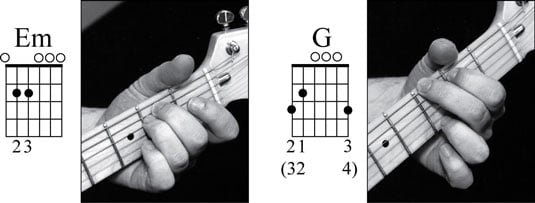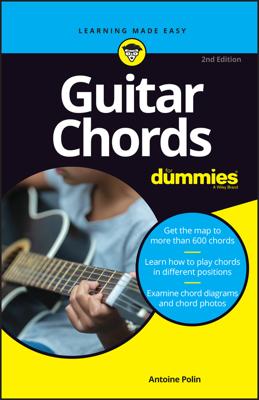The D family of chords is usually the second chord family that guitar players learn. This is primarily because it builds off the A family of chords. It builds on the A family of chords in that the D chord actually shares two basic open chords with the A family (D and A). If you already know the chords in the A family, this means that you only have to learn two more chords in order to play the entire D family. Listen to “Here Comes the Sun,” by the Beatles, to hear the sound of a song that uses D-family chords.
The basic chords that make up the D family are D, Em (E minor), G, and A. The new chords are Em and G. A chord that’s named by a capital letter followed by a small “m” is always minor, so the Em chord is a minor chord. Take a look at the fingering for the new chords in the A family.
The term minor describes the quality or sound of a chord. You'll notice that a minor chord has a sound that’s distinctly different from that of a major chord. Minor chords are often characterized as sad, mournful, scary, or even ominous. Remember that the relationship of the notes that make up the chord determines a chord’s quality.

To finger chords, use the “ball” of your fingertip, placing it just behind the fret (on the side toward the tuning pegs). Arch your fingers so that the fingertips fall perpendicular to the neck. Make sure that your left-hand fingernails are short so that they don’t prevent you from pressing the strings all the way down to the fingerboard.
Notice in the figure that none of the strings in either chord diagram displays an X symbol, so you get to strike all the strings whenever you play the G and Em chords. Also, notice the alternative fingering for G (3-2-4 instead of 2-1-3). As your hand gains strength and becomes more flexible, you want to switch to the 3-2-4 fingering instead of the initially easier 2-1-3 fingering.
Try the following trick to quickly pick up how to play Em and to hear the difference between the major and minor chord qualities: Play E, which is a major chord, and then lift your index finger off the 3rd string. Now you’re playing Em, which is the minor-chord version of E. By alternating the two chords, you can easily hear the difference in quality between a major and minor chord.
Here's a simple chord progression using D-family chords. The following figure shows a strumming pattern that divides the second strum of each measure (or the second beat) into two strums — up and down — both of which together take up the time of one beat, meaning that you must play each strum in beat 2 twice as quickly as you do a regular strum.
That square with the open bottom means that you strum down toward the floor, and the V-shaped symbol means that you strum up toward the ceiling — the symbols come from the bowing of orchestral strings like the the violin and cello. The term sim. is an abbreviation of the Italian word simile, which instructs you to keep playing in a similar manner — in this case to keep strumming in a down, down-up, down, down pattern.

If you’re using only your fingers for strumming, play upstrokes with the back of your thumbnail whenever you see the upstroke symbol.

